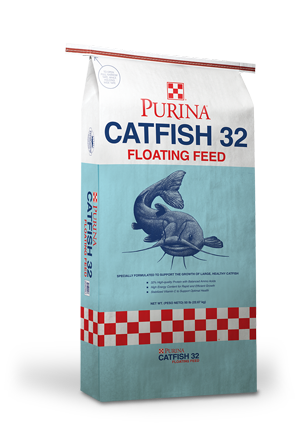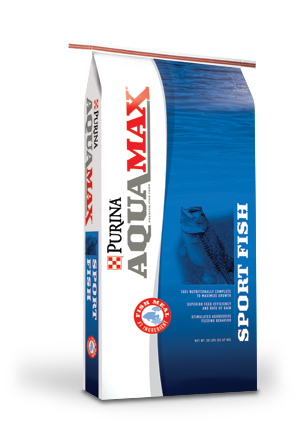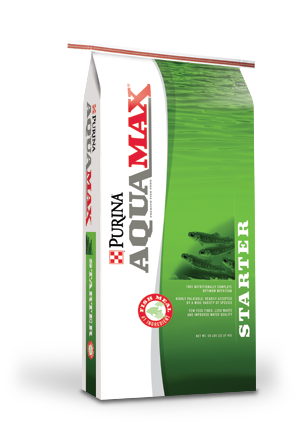
Game Fish Nutrition
Management : Nutrition

Proper nutrition is one of the key management factors required in establishing and maintaining a successful fish population in a pond.
Especially valuable is having an adequate crop of "forage" fish. These will be smaller fish, such as minnows, bluegill and small catfish. A sufficient population of these fish will provide the "food" that larger fish, such as bass and trout, will need to prey upon to thrive.
Catfish, bluegills, minnows and many other species all benefit directly from a supplemental feeding program. These fish tend to utilize feed extremely efficiently. In the proper environment, fish can convert feed at a 2:1 ratio, producing a full pound of weight gain for each 2 pounds of feed. Fish that are fed grow faster and have increased reproductive potential too.
Supplemental feeding will also attract forage fish to a specific area in a larger body of water such as a lake or river, which in turn, draws in and holds a larger sport fish population.
Remember, bass prey aggressively on bluegill, minnows and small catfish. Using supplemental feed helps you raise a better crop of forage fish, which then increases the capacity of your pond to grow and maintain a greater number of larger bass. Using supplemental feed also benefits your pond by supplying nutrients to the water which promote the growth of phytoplankton.
A supplemental feed with complete, balanced nutrition can provide increased resistance to disease and promotes faster fish growth than natural food alone. Look for feed that is formulated in multiple-sized floating particles to meet the feeding needs of a wide range of fish species and sizes. Feeding a floating ration has several advantages:
Begin your feeding program in the spring when water temperature rises above 55°F and continue until water temperature drops below 55°F.
A feeding ring can be very helpful in training fish to accept pelleted food. Typically made of 1½ inch PVC pipe, the ring is generally 10-12 feet in diameter and should be anchored so it is stationary. Toss the feed into the center of the ring, where it will remain until your fish discover and eat it. The ring prevents food from being blown to shore, decreasing waste.
There are several manufacturers of automatic feeders, which dispense a selected amount of feed on a timed basis throughout the day, they can be very effective and reduce time and labor.
In the process of training fish to eat pelleted feed, it is important to avoid fast, erratic movements that will alarm your fish and deter training. Move slowly and smoothly, remaining out of sight if possible.
Especially valuable is having an adequate crop of "forage" fish. These will be smaller fish, such as minnows, bluegill and small catfish. A sufficient population of these fish will provide the "food" that larger fish, such as bass and trout, will need to prey upon to thrive.
Benefits of supplemental fish feeding
A supplemental fish feeding program can help to ensure a consistent food supply for the sport fish in your pond.Catfish, bluegills, minnows and many other species all benefit directly from a supplemental feeding program. These fish tend to utilize feed extremely efficiently. In the proper environment, fish can convert feed at a 2:1 ratio, producing a full pound of weight gain for each 2 pounds of feed. Fish that are fed grow faster and have increased reproductive potential too.
Supplemental feeding will also attract forage fish to a specific area in a larger body of water such as a lake or river, which in turn, draws in and holds a larger sport fish population.
Remember, bass prey aggressively on bluegill, minnows and small catfish. Using supplemental feed helps you raise a better crop of forage fish, which then increases the capacity of your pond to grow and maintain a greater number of larger bass. Using supplemental feed also benefits your pond by supplying nutrients to the water which promote the growth of phytoplankton.
A supplemental feed with complete, balanced nutrition can provide increased resistance to disease and promotes faster fish growth than natural food alone. Look for feed that is formulated in multiple-sized floating particles to meet the feeding needs of a wide range of fish species and sizes. Feeding a floating ration has several advantages:
- It allows you to observe your fish – feeding a floating ration brings your fish to the surface. This is an outstanding opportunity to look at them and evaluate their health.
- It allows you to feed the proper amount – feed your fish only what they can consume in 15-20 minutes. If the fish eat all the feed in under 15 minutes, offer additional food. On the other hand, if you see food remaining on the water surface after 20 minutes, decrease the amount of food.
- Using a floating ration reduces the incidence of overfeeding which reduces water quality and oxygen depletion caused by food decay. Sinking feeds do not offer you this degree of control.
When to feed game fish
The best approach to feeding your pond fish is to develop a daily schedule so the fish are expected to eat. Morning and/or evening feedings usually work best. Fish can be fed twice a day during times of peak activity. If your schedule cannot accommodate daily feedings, research indicates that weekend or occasional feedings are still more beneficial than not feeding. Fish will be as consistent in their feeding behavior as you are in feeding them.Begin your feeding program in the spring when water temperature rises above 55°F and continue until water temperature drops below 55°F.
Where to feed game fish
Hand feed your fish from the same place each feeding. Choose a location from a dock or the bank where the feed can be broadcast over deep water.A feeding ring can be very helpful in training fish to accept pelleted food. Typically made of 1½ inch PVC pipe, the ring is generally 10-12 feet in diameter and should be anchored so it is stationary. Toss the feed into the center of the ring, where it will remain until your fish discover and eat it. The ring prevents food from being blown to shore, decreasing waste.
There are several manufacturers of automatic feeders, which dispense a selected amount of feed on a timed basis throughout the day, they can be very effective and reduce time and labor.
In the process of training fish to eat pelleted feed, it is important to avoid fast, erratic movements that will alarm your fish and deter training. Move slowly and smoothly, remaining out of sight if possible.
How much to feed fish
Several factors can have an impact on the amount of feed you need to use:- Stocking rate – ponds stocked at the high end of recommended levels will require additional feeders and feedings to support the good health of fish, since natural food stocks may be inadequate to support the population. Likewise, large ponds should have multiple feeding stations. One station for every 10 acres of surface area is adequate.
- Pond fertility – very fertile ponds with high levels of phytoplankton often have high levels of natural food, decreasing the amount of supplemental feed required.
- Water temperature – catfish, bluegills, and minnows will surface-feed when temperature is between 55°F and 85°F, with peak activity occurring at about 80°F. Reduce the amount of feed you use when water temperature exceeds 85°F; and do not feed at all when water temperature exceeds 90°F or during hot, still, cloudy days when phytoplankton are not capable of producing oxygen.



